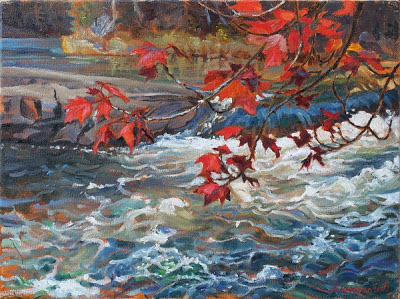Wood Frog breeding pond (watercolour, 4 x 6 in.) Sold
1 April finds us in a Wood Frog breeding pond which Fred calls "Site F" along Forsyth Road in Limerick Forest, Grenville County, Ontario. I pushed through willow bushes and past dry spruce boughs which caught at my sweater, stepping on mossy logs in the shallow pond edge, until I paused at one of the last two remnants of melting ice. The frogs quietened as I came out into the open, but resumed their chorus gradually as I stood still and got out my paints.
Most of them are calling from the dead cattails on the north side. Individually each Wood Frog call sounds like "duck, duck, duck" but as I made my preliminary pencil sketch, all together they sounded jubilant - a clamour like children in a playground. Later I noticed chuckling, and still later it seemed to me to have changed to laughing.
I painted the patch of ice first, but when it was time to leave I noticed that it had further melted to half the size! Fred took the water temperature over near the
chorus and it was 14C, the same as the air. No breeze, but very few mosquitoes. Wood Frog tadpoles eat a lot of mosquito larvae.
Canada: Ontario: Grenville County: Edwardsburgh: Limerick Forest/2.8 km S McReynolds. 31B/13, 44.86086N 75.63285W. HABITAT: small Elm/Salix pond in Pine plantations.
2010/034/d SITE F 1800- AKS to Site F to paint a typical Wood Frog pond, the E pond looking N from the S side, an area of heavily browsed, bright red Cornus (Dogwood), across a 4m patch of floating ice, ~~~-like Spirea alba w scattered stalks of \
The S side of the pond is a vehicle trackway in sand, all natural forest, flooded Fraxinus nigra (Black Ash) and Thuja (White Cedar) with 10-50cm small shade-fluffy Picea glauca (White Spruce) coming in under their shade. There's also some Rhamnus frangula, (Shining Buckthorn) but it's not yet dominant.
North of the pond is another sandy vehicle track, with huge White Cedars which have both healing-over and fresh Dryocopus (Pileated Woodpecker) excavations going into their inner Camponotus (Carpenter Ants). N of the track is the Pinus resinosa plantation, on undulating sand. E of the pond the new, deeply rutted motorcycle track, narrow ruts 30cm deep and flooded with water, comes down from the sandy bank to a plank bridge, and thru the swampy woods ard the pond.
Following this I find a big (35cm DBH) Populus tremuloides with a talus of Erethizon (Porcupine) droppings ard most of its circumference, and a swollen trunk with a big hole in it about 10m above the ground.
18h34: lull in Wood Frog calling
18h39 a breeze that we can't feel at ground level is roaring in the tops of the plantation.
18h40 Wood Frog chorus picking in W pond, and the small chorus on the E side stops, as if listening to that on the W.
18h41 Pseudacris crucifer (Spring Peeper) a few calls from the woods
19h21 painting finished -- the ice is only 60% of the area it was when the painting was begun. we'd earlier photographed the lines of bubbles left on the water ard the ice as it receded.
19h24 Mallard drake



Comments
Post a Comment
What do you think of this painting, and what do you know about the subject that I have painted?